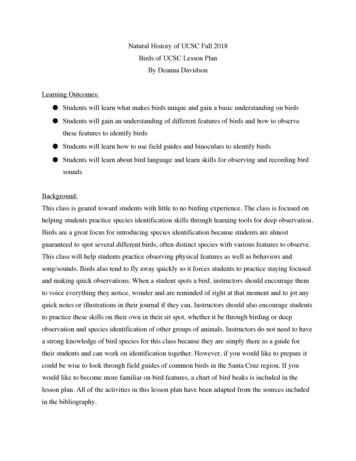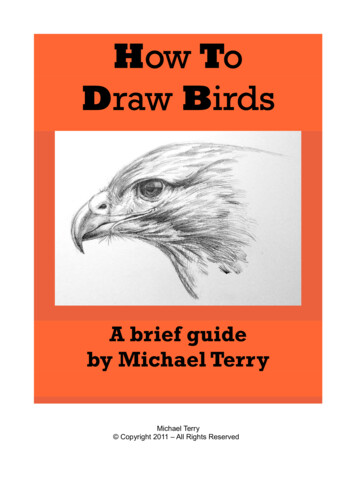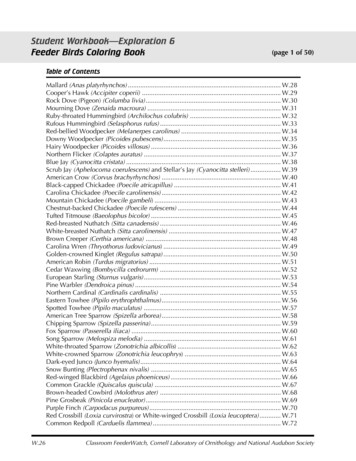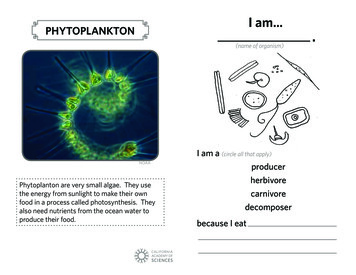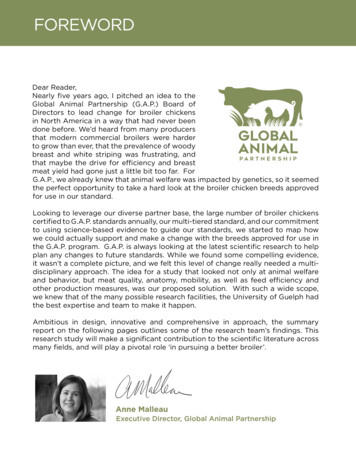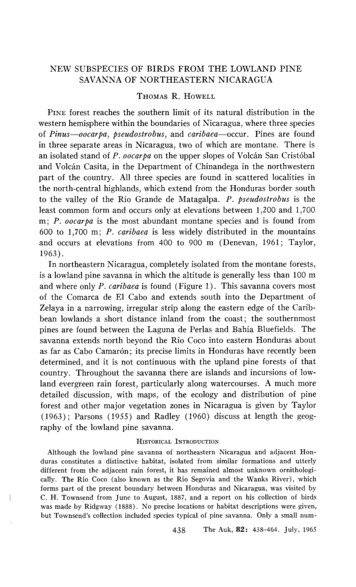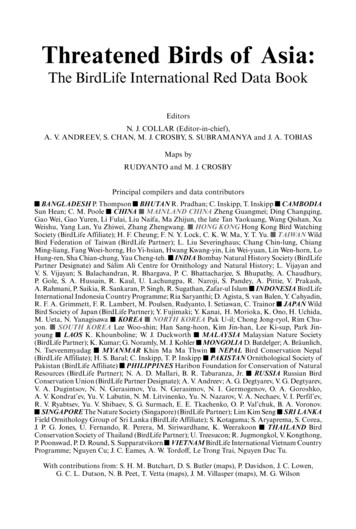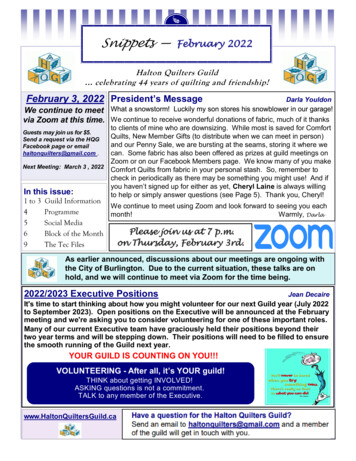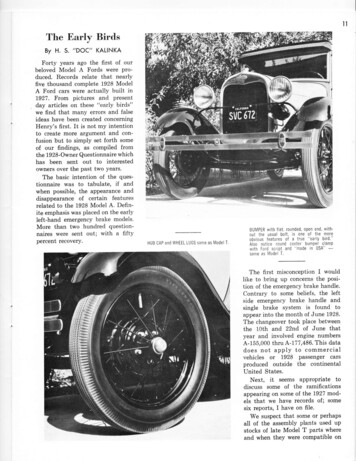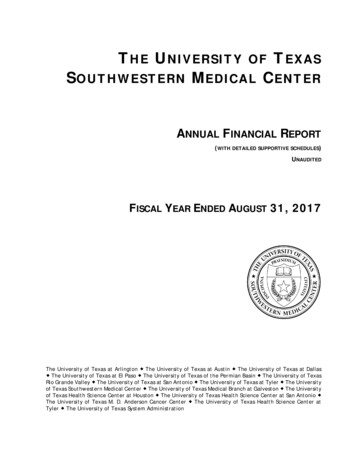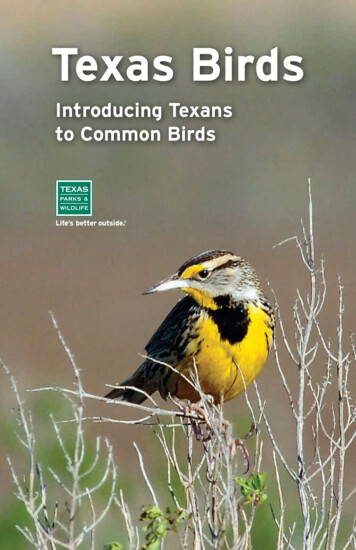
Transcription
Texas BirdsIntroducing Texansto Common Birds
Unless otherwise noted, photos courtesy of Jim DeVries.Cover photo by Chase Fountain, TPWD.Text by Mark Klym.Thanks to Matt Wagner, John Davis, Brent Ortego, Cliff Shackelford,Josh Rose, Ricky Maxey, Bill Johnson and Dave Holderman for their help. 2016 TPWDTPWD receives funds from the USFWS. TPWD prohibits discrimination on the basis of race,color, religion, national origin, disability, age, and gender, pursuant to state and federal law.To request an accommodation or obtain information in an alternative format, please contactTPWD on a Text Telephone (TDD) at (512) 389-8915 or by Relay Texas at 7-1-1 or (800) 7352989. If you believe you have been discriminated against by TPWD, please contact TPWD or theU.S. Fish and Wildlife Service, Office for Diversity and Workforce Management, 5275 LeesburgPike, Falls Church, VA 22041.
IntroductionBirding, enjoying the beauty of not only the colors and shapesbut also the behaviors and sound of birds around us, is one of thefastest growing pastimes in North America – and Texans have alot of birds that we can enjoy across the Lone Star State. Fromthe beautiful, aerobatic and feisty hummingbirds that dart backand forth around the beautiful flowers of our gardens, to thesilent owls patrolling our forests and field, Texas is by far themost bird diverse state in the nation.One of the best ways to learn to enjoy birds is by watching whatcomes to your own back yard. From the comfort of your back porch,you can see many of the birds shown in this booklet, depending onwhere your porch is. The availability of appropriate habitat featuresis the factor that will determine whether some of these species arepresent, and you will certainly not be able to see all of these birds inevery garden across the state, but you should be able to see enough ofthese birds to help you develop skills of observation that you can takewith you into the field wherever you go.You Can Help BirdsA quick look at the areas these birds are found in will show you thatmany of them are facing a loss of habitats. Birds that require trees orbrush find our cities unwelcoming because of the loss of these plants.Birds that require large open grasslands find large agricultural fields,industrial complexes or cities instead of the flowing prairie grassesthey need. These changes, often referred to as habitat loss, are themost significant threat birds face in North America today. Withouthabitat – appropriate food, shelter, water and space – animals are notable to survive.Since habitat loss is a significant threat to the future of birds in ourcommunities, the best way we can help birds is to replace or restoresome of that habitat. This has worked very effectively with somespecies. In the early 1900s, bluebirds – especially Eastern Bluebirds –were nearly wiped out by a lack of effective nesting sites following the
industrial revolution and the introduction of competitive foreign species.By putting back that habitat feature, in the form of a “bird house” inappropriate places, people were able to ensure that these birds will beenjoyed by our grand children for years to come.You can do the same thing in your back yard. A “birdhouse,” dependingon what plants are nearby, might be used by a chickadee, a wren, a flycatcher, a woodpecker, or any number of other common species. Somebirds do not use “birdhouses” though, and for these you may have toreintroduce some brush, some tall grasses, or even some trees to makethem feel at home. As you learn more about the birds you enjoy, youwill be able to change small things in your landscape that can make bigdifferences in what birds you see.Why Would I Want to Learn About Birds?The answers to this question are almost as numerous as the peopleasking the question – each and every person you ask will have adifferent answer. For some, the mere beauty of these animals isfascinating – colors from brilliant reds to subtle blues can be found inthe bird community. The delicacy of an animal that weighs only asmuch as a dime draws the attention of others, while still others arecaptivated by the concept of self propelled flight. Regardless of thereason you choose to learn about birds, spending time watching theseamazing creatures will be well rewarded!
Ecoregions of Texas
Neotropic Cormorant May plunge from as high as1/2 meter for fish—usually divesfrom the surface Produces a grunt call that is almostpig-like Also known as Olivaceous Cormorantor Mexican Cormorant Found near wetlands More common in southern reaches ofthe state during deer seasonDouble-crested Cormorant Produces a deep, gutturalgrunt sound Found in a wide variety ofaquatic habitats Dives only from the surfacewhen foragingAmerican Coot White billDistinctive, jerky swim behaviorLegs trail when in flightRuns to take offDives for aquatic plants
When in flight, egrets fold their necks back onthemselves, producing a “thick-neck” appearance.Cattle Egret Most likely associated withlivestock, since it feeds on insectsstirred up by grazing Produces a call that resembles“rick rack” StatewideGreat Egret Likely to be found in flooded fields,drainage ditches, stock tanks, pondsand waterways Call is a deep croak Seasonal occurrences statewideGreat Blue Heron Largest, most widespread heron inNorth America Call is a deep, hoarse croak, almostfrog-like StatewideGreen Heron Often perched on branches,especially over water Tends to hold head close to body Will frequently drop “bait” onto thewater to catch fish Call is a chicken-like “kuk”; willproduce an explosive “skeow” in flight Statewide
Birds of prey may be seen perched alongroadways, perched conspicuously invegetation or soaring over fields. Often,if other birds flush unexpectedly, lookingup might reveal a bird of prey.Northern Harrier Hunts flying low over grasslandsor weedy fields Large white patch on rump Call is sharp “kek” or “ke” notes StatewideRed-tailed Hawk Large, conspicuous hawk May not always display large,orange-red tail Call is a screaming “kreeeeear” Will hover on strong wind (kiting)while foraging Common statewideCrested Caracara Found in open savannah or desertFeeds on carrionOften misidentified as a Bald EagleAbsent from High Plains, Rolling Plainsand PineywoodsAmerican Kestrel Very colorful, small falcon Often found on roadside utility linesor fences Call is a whistled “klee klee klee” Less common in Oaks and Prairies,Osage Plains and Pineywoods
Loggerhead Shrike Called the “butcher bird” because itimpales food on thorns and fences Gray bird with black, hook-tipped bill Call is a harsh screeching note Uncommon to common statewideBarn Owl Becoming scarce and hard to findin much of its range Hunts on wing at night patrollingfor rodents Prefers more open areas Most common call is a loud,hissing shriek Uncommon statewide; accidentalto rare in Pineywoods and EdwardsPlateauEastern Screech-Owl Small “eared” owl; color may be grayor red Facial disk dissected by prominentridge at nose and bill Prefers open woods Common call is a whistled trill Uncommon to common statewideIn Trans-Pecos, High Plains, RollingPlains and Edwards Plateau, the WesternScreech-Owl may be as common or morecommon than its eastern cousin.
Great Horned OwlCHASE FOUNTAIN Large bird, varying shades of graywith barred breast and belly Large ear tufts, from which it getsits name; can be lowered Facial disk dissected by bill and nose Prefers wooded areas Common statewide except forPineywoods, where it is uncommon This is the “hoot owl”; its call isrhythmic hoots—“Who’s awake;me, too”Barred Owl Large, stocky red-gray owl withoutear tufts Wide vertical barring on chest and belly Distinct two-lobed facial disk dissectedby nose and bill ridge Prefers mixed wooded areas More common to the east in SouthTexas Thornscrub, Oaks and Prairiesand East Texas Pineywoods. Presentstatewide Call is the distinctive “Who cooks, whocooks for you all”Killdeer Although in the shorebird family, thisis a much more upland bird Generally found in grassy or gravellyareas, turf farms, muddy fields, etc. Listen for a long, drawn-out “deeyee”or “deeeeee” call Common to abundant statewide
Strikingly colored black-and-whitebird with all-red head Solid white patch on rump and baseof wings Will fly out to catch insects in air,and will store food Frequents mature stands of forest,especially with oak Statewide, but is accidental inTrans-PecosUSFWSRed-headed WoodpeckerNorthern FlickerGolden-fronted Woodpecker Brownish body with barred, black andwhite back and wings Gold nape and nasal bridge Prefer wooded areas Ranges from uncommon to commonstatewide, but absent from Pineywoods.In the Oaks and Prairies the Red-belliedWoodpecker would be much more common,while in the Pineywoods the Red-belliedWoodpecker replaces the golden-fronted.MARK KLYM Can climb trees and pound, but prefersto forage for ants and other insects onthe ground Call is strong “peah” often accompaniedwith “wik wik wik” or “wika wika wika” More likely in open wood or edgesituations Statewide; less common in thePineywoods.
Ladder-backed Woodpecker Small black-and-white striped woodpecker with a distinctly patterned face Male has red crown extending to the eye Prefers scrub Common statewide, but absent inPineywoodsEastern Phoebe Most likely in woodlands and alongedges near water May occasionally be seen eatingsmall fruit Call is two rough, whistled notesresembling “phee-bee” StatewideVermilion Flycatcher Fond of open bushes and treesnear water Call is a whistled “peent.” Song is aseries of trills and whistles Accidental in Pineywoods; very rareon Edwards Plateau in December.Common to uncommon statewideBlue Jay Bright blue back, gray face andbreast, white belly, black highlights Large, loud, aggressive bird Edge bird often associated withmixed or coniferous woodlands Call resembles “jeer” Statewide but scarce to absent inTrans-Pecos and South Texas
Western Scrub-Jay Blue back with gray patch acrossshoulders Pale gray streaking on breast Found in dense brushy areas.Associated with oak or juniper Harsh, scratchy call Absent from Pineywoods;accidental in South TexasAmerican Crow Large, overall black bird with shorttail and moderately heavy bill Often found in groups foragingon ground Distinctive “caw, caw” call Present statewide, but scarce inEdwards Plateau, South Texasand Trans-PecosChihuahuan Raven Longer-winged and heavier-billedthan crows Somewhat shaggy throat feathers Slightly rising “graak” call Absent from Pineywoods; accidentalin Oaks and PrairiesCarolina Chickadee Small gray bird with black cap andbib, white cheeks Raucous “chick-a-dee-dee-dee” call Absent to rare in Trans-Pecos, whereit is replaced by Mountain Chickadee
CHRIS HUNTBlack-crested TitmouseCHARLES H. WARRENTufted Titmouse Gray back, buffy side, black crest,pale forehead Call a very angry “ti ti ti sii sii zheezhee zhhe” Absent from Pineywoods; uncommonin Oaks and Prairies, where it isreplaced by the Tufted Titmouse Feeds on seeds and insects gleanedfrom leaves and branches Gray crest and black forehead distinguish it from Black-crested Titmouse Song a loud “peter peter peter”; call ascratchy “tsee-day, day, day,” almostchickadee-like Deciduous forests, swamps andorchards are preferred habitat types Replaces Black-crested Titmouse inHigh Plains and Rolling Plains, Oaksand Prairies, and East Texas PineywoodsVerdin Gray bird with yellow headGleans insects from twigs and flowers.Call a high-pitched “tseewf”Absent from Pineywoods; rare in Oaksand PrairiesCarolina Wren Feisty little red bird with abundantstriping on wings and tail—tail oftenheld vertically Prominent white eye stripe borderedby black Long, pointed black bill Song is loud “teakettle, teakettle,teakettle, tea” Common to abundant statewide
Bewick’s Wren Small brown bird with short, striped tail Eye stripe very pale to nearly absent Gardens, hedgerows and brushy woodsare favored Very bubbly song. Call is a sharp “chek” Very rare to common statewideRuby-crowned Kinglet Very tiny bird—about the same size asthe common species of hummingbirdsin Texas Male crown is seldom seen Call a quick “di-dit.” Song a jumble of notesusually starting with “tsees” followed by“tur” and ending with “tee-dah-let” Usually gleans from the end of branches StatewideUSFWSHouse WrenUSFWS Small, gray to red-gray bird with long,striped tail often held high to nearvertically Prominent white eye stripe Gray on side of neck Fond of dense, brushy habitats Song is an elaborate series of whistledphrases and trills; call is raspy andscolding Scarce in Pineywoods; common toabundant otherwise Blue back, orange-red throat andbreast, white belly Found in groups in fields and openwoods, may be seen perched on overhead lines or in trees During winter may be feeding on smallfruit; also eats insects Song a warbling whistle “tu-wheettudu”; also dry chatter Uncommon to common statewide.In west more likely to be replaced byWestern or Mountain BluebirdsUSFWSEastern Bluebird
Hermit ThrushTPWD Brown-gray bird with heavily spottedbreast; reddish tail Prefers somewhat open brushy habitat Song starts with a whistle followed bymonotone warble This is a migrant, often arriving duringhunting season in small numbersAmerican Robin This is the familiar bird with the grayback, black head and bright red breast Eats insects but will also take fruit Call a sharp “chup”; song a melodious“cheerily, cheerup, cheerup, cheerily,cheerup” Becomes more common in late winterNorthern Mockingbird Our state bird is very common toabundant statewide Gray overall, darker on back, largewhite patches in wing Thin, dark line through the eye Song varies as this bird “mimics”sounds heard; is very repetitive Open ground with shrubby vegetationis preferredBrown Thrasher Song variable phrases usually utteredtwice. Call note a thick “tchuck” Thickets and brushy woodland edgesare preferred habitat types Statewide; less common in EdwardsPlateau, South Texas Brushlands andTrans-Pecos
Orange-crowned Warbler Distinctly striped head withcentral, rufous stripe bordered byblack stripes, and white crownimmediately above eyes Song a clear whistle with buzzesand trills Likely to be found in weedy,brushy areas Migrant species increasing innumbers later in the winterWhite-throated Sparrow Song is “Oh Sam Peabody PeabodyPeabody”; call is a “tseep” Dense cover along woodlots, fencerows,swamps, weedy fields, etc. StatewideNorthern Cardinal Call is a sharp “chip”; song a clear“cheer, cheer, cheer, what, what, what” Brushy habitats in open areas Common statewideCHASE FOUNTAINWhite-crowned SparrowUSFWS Song is a fast trill changing in pitch,while call is a sharp “chip” This bird is closely associated withshrubs and trees Rapid moving bird that flits among thetips of tree branches gleaning insects Statewide
Meadowlarks The two species of meadowlark are verydifficult to distinguish except by sound Large, striped birds with yellow breastand belly, black bib, long pointed bill Grassy habitats where they prefer toperch on fences or in bushes Also called “field larks” Eastern Meadowlark song is plaintive;clear whistles slurred and usuallydescending at the end Western Meadowlark song is rich, fluteywhistles ending in gurgling whistles Common to abundant statewideCommon GrackleTPWDTPWD Song is a harsh, unmusical “readle-eek”;call a harsh “chack” Open woodland, swamps and marshes,and agricultural areas are likelylocations for this bird While closely related, this is not theurban Great-tailed Grackle that peopleoften dislike Rare in the Trans-Pecos but can befound statewideBrown-headed Cowbird Found in woods, edges or open fields,especially if livestock is present Usually found in large flocks Male has a brown head over black body;female gray-brown overall Stout bill; eats seeds and arthropods Common to abundant statewideRed-winged Blackbird Male distinctive black bird with largered patch on wing Female nondescript striped bird withthick bill Male distinctive “kon-ka-ree” call Seldom far from water; prefers moist,marshy areas Common to abundant statewide
SummaryThe diversity (numbers and different kinds) of birdsfound in any location will be very dependent on thehabitat available to the animals. Understanding thehabitat, and the role of different features in the bird’slife, will help you not only to find more birds but alsoto become a better conservationist. Understandingthe bird behavior will help you to understand andpredict changes in the habitat around your home andhelp you to conserve and protect the natural beauty ofyour region. Good birding.For More InformationTexas Parks and Wildlife bird wild/wild/species/nongameBirding in Texas State -to-do/birding-in-state-parksWorld Birding Centerwww.theworldbirdingcenter.comCornell Laboratory of Ornithologywww.allaboutbirds.orgUSGS Patuxent Labwww.pwrc.usgs.govAudubon Texashttp://tx.audubon.orgTexas Ornithological Societywww.texasbirds.org
4200 Smith School RoadAustin, TX 78744www.tpwd.texas.gov 2016 TPWDPWD BR W7000-1673A (5/16)In accordance with Texas State Depository Law,this publication is available at the Texas State PublicationsClearinghouse and/or Texas Depository Libraries.
Large bird, varying shades of gray with barred breast and belly Large ear tufts, from which it gets its name; can be lowered Facial disk dissected by bill and nose Prefers wooded areas Common statewide except for Pineywoods, where it is uncommon This is the "hoot owl"; its call is rhythmic hoots—"Who's awake;
